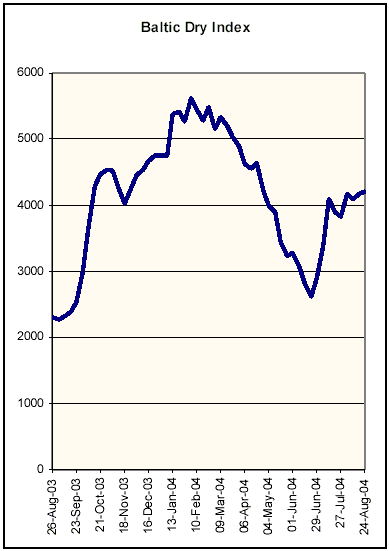


 |
 |
|
 |
||
|
|
||
|
|
|
| †food outlook | |
| No. 3 | Rome, September 2004 |
|
Ocean Freight Rates(Contributed by the International Grains Council) The Panamax dry bulk market rose sharply in the first half of July across all size ranges, both in the Atlantic and the Far East, mostly due to a surge in short-period fixtures. The main support was from the mineral trade with increased demand from Japan, Europe and China. An increased number of grain cargoes from South America, and Chinaís decision to resume soyabean imports from Brazil, contributed to the marketís bullish sentiment.  In August, the market continued to firm, although at a slower pace than in the previous month, due to strong demand for iron ore from China and for coal from Europe and also Japan, following problems at its nuclear power stations. The market also expects demand for new crop grains to pick up from September onwards. Since the end of June, the Baltic Dry Index (BDI) gained 1†318 points (45 percent), closing at 4†213 on 24 August. In the Atlantic, the major grain rate from the US Gulf to Japan went up during July and August from US$37.00 to US$53.75 per tonne, while timecharter rates were up by about US$3†000 per day, to US$32†000-US$33†000, plus a ballast bonus of US$600†000. Panamax rates in the Pacific increased steadily from US$22†000 per day to US$35†000, with a correction to US$31†000 by the end of August. Japanís imports of coal from Australia, and renewed Chinese chartering supported this market. Capesize period rates in the Pacific continued to rise, increasing from US$80†000 to US$90†000 per day due to increased chartering activity by China and Japan. In the Atlantic, rates at the end of August were reported to have reached US$72†000 per day, compared with US$45†000 in June. An iron ore cargo was fixed from Brazil to the EU (Rotterdam) at US$19.00 per tonne in August. Strong demand was reported in the Baltic Capesize market, as Europe started to stockpile coal for the winter. Rates from South Africa to the EU (Rotterdam) approached US$18.00 per tonne. The Handysize rates in the Pacific started to slide due to plentiful available tonnage, with round trips quoted lower at US$25†000 per day (US$26†500). In the Atlantic, the grain rate from Brazil to the EU (Antwerp-Hamburg) was indicated at US$37.50 per tonne at the end of August, US$7.50 higher than two months previously due to increased enquiries. |
†
†
†